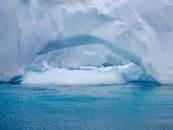
The Arctic’s Ticking Time Bomb
The Arctic is home to vast amounts of methane gas, trapped beneath a thick layer of permafrost. Every year these organic carbon reservoirs grow as the cold climate traps plants and animals below the topsoil and prevents decomposition. These Arctic reservoirs account for nearly half of all organic carbon stored within the planet’s soil.
Permafrost temperatures are rising at a much faster rate than the Arctic air temperatures, rising between 2.7 and 4.5 degrees in the last 30 years. As a result, permafrost layers are melting. A 3 degree Celsius increase in global temperatures could melt 30-85% of the top permafrost layers. If these top layers continue to melt, the vast carbon reservoirs might release into the atmosphere as either carbon or methane, upsetting the Arctic carbon balance and intensifying global climate change.
In the Arctic, an estimated 1,400 to 1,850 petagrams (one petagram is 2.2 trillion pounds) of organic carbon lays dormant just 10 feet below the frozen permafrost. In comparison, total global fossil fuel combustion has released 350 petagrams of carbon into the atmosphere since 1850. If the remaining 1,400 petagrams of organic carbon escaped the Arctic permafrost, the effect on climate would be catastrophic.
If climate change causes the Arctic to become dryer, scientists expect the Arctic carbon to be released as carbon dioxide due to the increased availability of oxygen. If the climate becomes wetter, the lack of oxygen will cause anaerobic bacteria to break down the hydrocarbons into methane. In the short-term, the release of methane would have a substantially larger effect than carbon dioxide on global temperatures. Methane is 22 times more potent as a greenhouse gas than carbon in a 100-year time scale and 105 times more potent in a 20-year time scale. If just one percent of the Arctic organic carbon releases as methane, it will have an equivalent effect on the climate as the other 99% of the organic carbon released as carbon dioxide.
Our current climate models do not account for the thawing Arctic permafrost or the carbon reservoirs that could rapidly accelerate global climate change.
A NASA Earth Ventures Program named CARVE is testing the effects of climate warming on carbon reservoirs below the Arctic permafrost. Early results from CARVE show that the Arctic is warming two to three times quicker than mid-latitude regions. Between the last spring thaw and fall freeze, the team observed large episodic bursts of carbon dioxide and methane in Alaska and the Northern Slope. In July 2012, CARVE noticed methane levels in the Innoko Wilderness that were 650 parts per billion higher than normal, similar to levels found in large cities.
If large amounts of methane begin to escape, the powerful effects of climate change may damage the earth’s delicate system. More methane will increase global temperatures, which will melt more permafrost, thus releasing more methane. The CARVE scientists do not believe the Arctic has reached the tipping point of no return, but they are unable to know for sure. Research certainly indicates that an irreversible permafrost tipping point exists, and crossing that threshold will create devastating consequences for the global climate.
To read more by ASP on this issue, click here.







[…] energy issues, and the European Union’s Eastern partnership. On Our Flashpoint Blog The Arctic’s Ticking Time Bomb William Joyce The Arctic is home to vast amounts of methane gas, trapped beneath a thick layer of […]
[…] “Statements don’t make a peace agreement”: Aqab Malik on Pakistan/Taliban Negotiat… Katrina Trost Thursday visiting National Defense University Assistant Professor, Aqab Malik, spoke at the John Hopkins School of Advanced International Studies on Talking with the Taliban: A Strategic Dilemma for Pakistan. Having spent significant time with the Taliban in both Pakistan and Afghanistan, Malik offered insights to negotiation potential with the Pakistani Taliban and central Pakistani government. […]